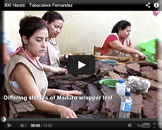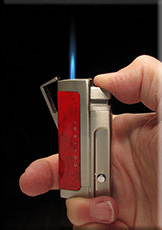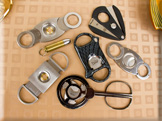
On or off, it’s a matter of taste.
Well, maybe it’s not the last, last word, but for the benefit of newbie cigar smokers, it’s a subject worth revisiting.
When I first started smoking cigars in 2005, I was very confused. The amount of information regarding cigars seemed overwhelming. To add to my confusion, opinions seemed to run in polar opposites. This was the main reason I started Robustojoe.com. I wanted to see for myself, through empirical analysis, the “truth” behind all the hype and opinion. One of my first dilemmas was whether or not I should age my cigars in their cellophane sleeves. One thing was clear: cigars age faster with the cello removed. All the experts seemed to agree on this. At that time, I was led to believe that aging cigars was a good idea. I now know that isn’t always the case. But back then I was convinced my cigars would improve over time.
In the beginning.
As a newbie, I read that aged cigars were better than new ones. This made sense, and the highest rated cigars in Cigar Aficionado were always aged Cubans. Because of this, I went so far as to remove the cellophane from all my cigars. This was a bother. Removing the cello, then reassembling the cigars in the box was difficult. I had to be careful not to damage the fragile cigar wrappers. But this seemed like the best way to age my cigars quickly. Unfortunately, I found that over time, most of my cigars lost flavor. Some of the stronger brands, like Tatuaje, did mellow out in a good way. But after a few years, most of the “old school” cigars simply got flat with aging.
Then one day while visiting a local B&M, the owner offered to sell me some cigars he had on consignment. They had come from someone’s collection. I purchased a few old Fuente Opus Xs, and some Padron Anniverseries. The Opus X cigars were in cello, while the Padrons were “naked”. Upon smoking I was struck by how good the Fuentes tasted while the Padrons were almost tasteless. This led me to think that the cello kept the flavor intact. Over the years I discovered that Padron cigars (particularly the maduros), should be smoked immediately, and simply don’t age well, and that the stronger Opus X are better suited for long term storage. But I believe that had the Padrons been in cello, they would have tasted better. That was about five years ago, and since then I stopped removing the cello from all my new cigars. I’m now very glad I did.
That factory aroma.
I went on my first cigar trip to Nicaragua in 2010 . It was an amazing experience on many levels. But what impressed me the most was the wonderfully intense aroma in the cigar factories. It was like a cake lover visiting a bakery. That fermented tobacco smell hits you, and you are in cigar heaven. And there is nothing like smoking a cigar right off the roller’s bench. A cigar that fresh has flavor so unique, it’s unequalled in anything store-bought. While in Nicaragua, I accumulated a nice bundle of samples from each factory I visited. Once home, I found that the cellophane had captured and retained that wonderful factory aroma. I was able to relive the factory visit with each cigar I smoked from the trip. Now I smoke all my cigars right out of the cello, and the great un-lit tobacco aroma brings me back to those cigar pilgrimages. The cigars I’ve stored sans cello have far less tobacco aroma. I miss that.
Cello and storage.
Another big advantage of cello is protection. Cigars are fragile. But above all, it seems to protect against tobacco beetle infestation. I don’t know if it is the cello alone, but when the weather gets hot, many of my unprotected cigars are ravaged by bugs. To date, none of my cello’d cigars have had problems.
How fast can I smoke?
Avid cigar smokers tend to collect more cigars then we smoke. We may buy a box, smoke a few, and then move on to another cigar brand that seems promising. It’s fun to, over the years, revisit the boxes we’ve collected. These days, Non-Cuban cigars are well fermented and meant to be smoked right away. It is unnecessary to age them. Here again, the cello has an advantage. By slowing the aging process, the cigars stay fresh, and the flavors of the original blend remain intact. Years later they still taste as the blender intended.
Complexity.
Lastly, when a cigar comes right from the cello, it has complexity that fades quickly over time. In the case of an overwhelmingly strong cigar, it might be advantageous to let it air out without the cello. This happens within hours of removal, and it can be nice to remove the cello a few days before smoking. In some cases, I’ll take a couple of sticks, remove the cellos, and put them back in the box for later consumption. But I always leave the majority of the cigars in a box with the cello intact. It may be years before I get to the bottom of that box, and I don’t want any disappointments.
Conclusion.
If you are a newbie, or simply undecided about what to do regarding the cellophane sleeves, I hope this has given you some ideas about how to proceed. Ultimately, it is an individual preference, and each of us will determine what works best for our tastes. But there is little doubt that the cello greatly affects the flavor of our cigars. For me, I want all the flavor the cigar blender intended, so I’m a “cello on” guy. What are you?
Thanks for listening.
Joe












You must have a poor humidor. I always remove the cello and the bouquet when I open the lids of my humidors to take out a cigar is that same intense aroma you describe. And I recently enjoyed both a Partagas Lusitania bought in 2001 and an H. Uppman #2 (both Havanas) and they were even better than when I purchased them.
Thanks for your comment.
My humidor is well maintained and all my cigars smoke well. I have a collection of about 3,000 cigars. Also, this article is about Non-Cuban cigars which are very different from the two cigars you mention. As I wrote in the article, it’s a matter of taste. You are a “cello off” guy.
The “bouguet” you smell are all the organic compounds releasing into… you guessed it… the air. A majority of the compounds that were once within the cigar are no longer present as they have gassed out from years of minor temp and humidity fluctuations. It may smell good, but the cigars have probably lost a majority of their flavor compounds.
You should smell “some” tobacco and mostly cedar in a humidor.
I have a walk-in humidor with about 4,000 sticks. For the first six years I always removed the cello’s from my non ISOM cigars. I did this under the presumption of a better aging process. However, I found that many of the cigars lost their individuality and complexity, both in aroma and flavor. A year ago I started to leave the cello wrappers on the new boxes of cigars added to my humidor. So far I have found that these cigars have maintained their character and have come along nicely. Therefore, I am going to leave on the cello until I find that the maturation process is truly being hindered.
Additionally, Colin Ganley of CigarTourism.com and former editor of the Cigar Journal magazine preaches that the cigars should be left cello’d and after a few months of humidor rest, should be smoked not left to age. The factories are shipping the cigars the way the blenders and manufacturers are intended them to smell and taste. Why not smoke them accordingly?
Hey Joe. Great article, thanks for posting it. Nicaraguans are amongst my favourites and being from Canada where I can travel to Cuba, that’s saying something.
I DO find it hard to believe a Padron Anni could be flavourless. I have numerous N-C cigars over 8 years old, both in cello and naked and i can’t say I’ve experienced that. Is it possible it’s unique to the Annis for some reason?
Again, thanks. Looking forward to reading more from you.
Jamie, thanks for commenting. I don’t know why (and I should have been more specific in my article), that my Padron Anniversary MADURO cigars lost their richness over time. I keep my cigars at 71% so they are not drying out, but I think Padron maduros are better, for me, smoked new. But again, it’s a matter of individual taste.
I was wondering if you still stored your cigars at such a high humidity
Yes, sort of…the temp in my humidor is around 76°. So if my humidor was at 70° per the 70/70 rule, my humidity would be in 70% range. So, technically, my humidity isn’t really that high.
My humble collection is about a tenth of Joe’s but spread out in 4 different humidors all powered by Boveda packs. I tend to separate my cigars by country of origin and 2/3rds of my sticks are from Nicaragua and these occupy 2 of my humi’s. I have one for Honduran and one for Dominican. I always leave cello on my sticks as I find that if I toss unwrapped sticks in the same tray that the milder sticks absorb oil and flavor from the more robust sticks.
I only have 15 to 20 cigars in the humidor at a time, all with cello. Enjoyed the article, thanks.
My dear friend, that trip to Nicaragua was indeed educational, and your article on the pros and cons of the cellophane wrapper is very informative. I have to add a few additional thoughts to what has been discussed so far.
Since returning from trips to the factories in Nicaragua and Honduras, I have seen and experienced the entire process from seed to cigar. It is interesting that most cigars are shipped with the cello wrapper.
Do these manufacturers know something that we do not, or is it simply for the added protection? We all know that wrappers can be extremely delicate. (Try applying a wrapper to a cigar, and you will quickly see how easily the wrapper can be torn and damaged.)
As I get to meet more cigar makers, I am going to pose this very question to them to get their take on the subject! Once I hear from some of them, I will drop another note here.
Keep on smoking, everyone! Enjoy!
Hi Joe. Yeah, that trip was memorable. To your point, it would be great to hear the manufacteruers explanations as to why they use cello. I would imagine it’s to protect the cigars, AND retain their flavor.
Hey Joe. Thanks for another insightful article on a subject that comes up all too often. Here’s my take:
I used to remove all the cellos on my cigars, for basically the same reason you did. Some of those cigars are still in my humidor almost 8 years later, and I’m happy to report, except for a few mild sticks, they have held up in flavor and aroma.
You wrote: “Non-Cuban cigars are well fermented and meant to be smoked right away. It is unnecessary to age them.” 99% of my collection are non-Cubans, and except for my “everyday” cigars, they have all been aged to some degree with significant improvements. It may not be necessary to age them if you’re referring to long time periods of one year or more, but I see no harm in letting them sit for a 2-4 week period before smoking them.
Due to fluctuations in outdoor temperature and humidity (which will affect your humidor), and to prevent my best cigars from getting beat-up while sifting through my humidor, lately, I have gone the “compromise” route: I leave them in the cello, but clip the end to allow some air flow into the tobacco. These latter cigars seem to hold-up and taste much better.
Finally, and this is just MHO: 71% humidity is a bit high, but maybe because you live in an arid state it works for you. I have found that keeping my humidors at an average RH of 68% works best for me. Moreover, some experts believe maduros should be aged at a lower RH. That could be part of the reason your Padron ’64 maduro didn’t retain its flavor profile.
G~
Hi Gary. You make some good points. I keep my cigars on the humid side because I’m afraid they might dry out over years of storage. I live in a warm, dry climate, and each year the temps keep going up. I’ve noticed that as the temps rise, so does the humidity in my humidor. The subject of RH is confusing, and I’ve been unable to get an explanation I could truly understand. But when my temps go down to below 70 degrees, my RH drops as well. So my 71% at 74 degrees, might not be much different than yours in terms of RH. That being said, my cigars smoke and taste better when I’ve dry boxed them a few days before smoking.
I leave ’em as the good roller made ’em… If they come in cello, they stay that way…
Joe I couldnt agree with you more. I was in the cello off camp for a long time. But I found that when would smoke out of my coolidor ( cello on) as opposed to my desk top ( cello off) the cigars were so much better. Now its cello on for me.
For know i need to buy a lot of cello ciggars sleves and after that i need to know where to buy a cello machine for ciggars
Good article and I complete agree: cello on is the way to go. My collection, although much smaller than yours, has enough sticks in it that I probably wouldn’t get to them all within a year. Most of my un-cello’d sticks are ones I have purchased and they taste noticeably different from those that are the same stick with cello. The loss of complexity is a bummer, especially when you recall what the wrapped versions gave you flavor wise. I really wish Padrons and Cubans came with cello but for now when I get them I usually let them rest a week or so and try to smoke them- or store them separately (even if that means putting them in a ziploc bag with a Boveda) from others so the flavors don’t get too muddy.
Unless I’m traveling or gifting, I remove cello before placing in a humidor. This is to humidify the entire cigar equally and age out any ammonia issues that can surprise in the last 3 inches of a cigar. I’m using three humidors and two well made cigar boxes that act as humidors. Two humidors carry mostly Nicaraguan puros and a few Cubans, one carries a blend of churchill maduros and naturals, my power box contains 601 Pennsylvania and Casa Magna only. Final box contains hard to find and allocated Fuente sticks
Everything in this article is 100% on point. NEVER EVER take the cello off unless you enjoy mild-medium one dimensional smokes. I made this mistake 8 years ago and I have regretted doing that ever since. The people who say that it makes no difference are doofuses and clearly have never experienced both sides of the spectrum. The difference is so great that I now go so far as putting sticks in cello/single ziploc baggies what never were wrapped in cello.
Cigar appreciation is so much about how we have “trained” our palates. Some of my friends love strong, earthy cigars, with a spicy tingle on the tongue. Others, particularly those who only smoke Cuban cigars, fine that flavor profile repulsive. My tastes have evolved over the years, and change periodically depending on what I am smoking lately. But presently, I store my cigars in cello, but always keep a few cigars naked. These will mellow out just enough to smooth any edges in flavor. I don’t like aggressive cigars, and these days, a bold, in-you-face flavor profile is in vogue. A few days, or even weeks without cello will put an Esteli Nic, puro into my comfort zone.
I took cellos off of strong cigars, which I love, and found out they mellowed out very quick. I dont like that. They taste flat. Im used to the fresh taste of a cello’d cigar. Much stronger and rich. I started taking the cellos off because I felt they were a humidity barrier, but if thats the case, giving them plenty of time to acclimate (about 2-4 weeks) which might not even be necessary as they come in good shape already when bought, is more than enough for humidity. I’m smoking a aj new world ct out of a brand new box that had the cello on and it tastes way better than the ones I was smoking from the previous box where I had taken the cellos off. No more cellos off for me thats for sure.